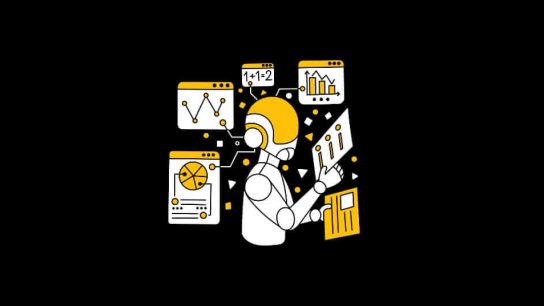An introduction to Q*
OpenAI is a non-profit organization dedicated to developing and promoting artificial intelligence (AI) and creating artificial general intelligence (AGI) that can rival human intelligence. Recently, it was reported that researchers at OpenAI have made a breakthrough in AI. They have developed a new AI model named Q* (pronounced Q star). What is Q*, its characteristics, and how can it impact our lives? This article briefly introduces Q*(star) and analyses the associated issues.

Multi-language model
Q is a multi-modal language model that can understand and generate natural language or code. Based on ChatGPT and GPT-4.0 under OpenAI, it is improved with broader common sense and more advanced reasoning capabilities. Q can solve some more complex problems, such as:
Logical reasoning: Users can ask Q* a logical question, and it will give a correct answer or proof process.
Knowledge Q&A: Users can ask Q* a knowledge question, which will give a detailed answer and provide relevant links or pictures.
Text summary:
Users can provide a long text to Q*, concisely summarising the primary information.
Code generation:
Users can provide a long text to Q*, concisely summarising the primary information.
Users can provide a functional description to Q*, which will generate a code snippet that meets the requirements.
Q’s innovation is that it uses a technology called “process supervision,” which can train the AI model to decompose the problem-solving process into several steps, thereby improving the algorithm’s accuracy and reliability. This technique can help Q avoid common mistakes like calculation or unit errors when dealing with math problems. It was reported that Q* could already solve some elementary school-level math problems, which is considered an important milestone towards achieving AGI.

The emergence of Q may bring convenience and fun to our lives. For example, we can use Q to help us learn new knowledge, complete complex tasks, and even create something new. Q can converse with us, answer our questions, advise us, and even joke with us. Q can also see, hear and speak; users can show it pictures or voices, and it will respond accordingly. Q can also create new images based on user descriptions, such as new logos, comics, or realistic scenes. For example, I can generate a logo for Q and an architecture diagram for Q*.
Limitations and risks of Q*
Of course, Q also has some limitations and risks, such as producing wrong or meaningless answers or being used for evil. Therefore, we must use it rationally while considering its ethical and social implications. OpenAI’s mission is to ensure that the development of AI can benefit all humanity, not just a few people or machines. We want Q to be a helpful partner rather than a dangerous adversary.
Reinforcement Learning: An Introduction” by Richard S. Sutton
If you want to learn more about Q-learning, you can read the famous “Reinforcement Learning: An Introduction” by Richard S. Sutton, the father of reinforcement learning.
It is worth noting that the RLHF method used by OpenAI for ample model training is designed to allow the model to learn from human feedback rather than relying solely on predefined data sets.
Human feedback can take many forms, including corrections, rankings of different outputs, direct instructions, and more. The AI model uses this feedback to adjust its algorithms and improve responses. This approach is beneficial in challenging areas where clear rules are defined or exhaustive examples are provided. Some speculate that this is why Q* was trained in logic and eventually adapted to simple arithmetic.
However, how practical can Q-learning algorithms be in achieving artificial general intelligence (AGI)?
AGI refers to the ability of an artificial intelligence system to understand, learn, and apply its intelligence to a variety of problems, similar to human intelligence. While Q-learning is powerful in specific domains, implementing AGI requires overcoming challenges, including scalability, generalization, adaptability, skill sets, and more.
Combine Q-learning with other deep-learning methods
Many recent studies have tried to combine Q-learning with other deep learning methods, such as combining Q-learning with meta-learning to let AI learn to adjust its learning strategy dynamically.
These studies have indeed improved the capabilities of AI models, but it is still unclear whether Q-learning can help OpenAI achieve AGI.
Some people also speculate that Q* is the legendary breakthrough of Alpha Star-style search + LLM, which is the direction many AI Labs are working towards. However, considering the limited improvements in some previous attempts at GPT-4 self-verification + search, we are still far from AGI.

If, as various media outlets report, Q*’s breakthrough means that the next generation of large models can combine the deep learning technology that powers ChatGPT with rules programmed by humans. This approach could help solve the hallucination problem that plagues current large models.
This could be an essential technological development milestone. On a practical level, AI is still far from ending the world.
Is Q* going to lead to general artificial intelligence
“I think the reason people believe Q* is going to lead to general artificial intelligence is because, from what we’ve heard so far, it seems like it’s going to bring both sides of the brain together and be able to learn things from experience, while still being able to reason about the facts,” said Tromero co-founder Sophia Kalanovska. “This is a step closer to what we consider intelligence and more likely to allow the model to generate new ideas.”
The inability to reason and create new ideas and summarize information from training data is seen as a limitation of existing large models, and even those involved in research in these directions are limited by the framework.
Andrew Roginsky, head of the Human Centered AI Institute at Surrey College, believes that solving never-before-seen problems is a key step in building AGI: “In terms of mathematics, we know that existing artificial intelligence has been proven to be able to do undergraduate-level mathematics. Operations, but cannot handle more advanced mathematical problems.”
“However, it would be a big deal if AI could solve new, unseen problems rather than just regurgitate or reshape existing knowledge, even if the problems involved are relatively simple,” he added.
Only some people are so excited about the breakthroughs Q* could bring. Gary Marcus, a well-known AI scholar and professor at New York University, published an article on his blog expressing doubts about Q*’s reported capabilities.
“OpenAI’s board of directors may have concerns about the new technology… Although there is some talk that OpenAI is already trying to test Q*, it is unrealistic for them to change the world completely in a few months,” Marcus said. “If I had a nickel for every inference I made (that Q* might threaten humanity), I’d be a Musk-level richest man.”
In conclusion, the emergence of Q*, OpenAI’s latest AI model, marks a significant advancement in the quest for artificial general intelligence (AGI). Q* embodies a multimodal approach adept at understanding and generating both natural language and code. Its innovative “process supervision” technique enables step-by-step problem-solving, enhancing accuracy and reliability, which is evident in its ability to tackle elementary math problems.
While Q* promises to revolutionize various aspects of our lives, from education to creativity, it has limitations and risks. Ethical considerations are paramount, ensuring its use benefits humanity without causing harm. The integration of reinforcement learning, particularly human feedback, underscores OpenAI’s commitment to responsible AI development.
The potential of Q* to bridge the gap between learning from experience and reasoning about facts suggests a step closer to accurate intelligence. However, scepticism persists among experts regarding its reported capabilities and the trajectory towards AGI. Addressing unprecedented challenges and fostering creativity remains pivotal in realizing AI’s full potential.
In essence, Q* represents a significant milestone in AI development, yet the journey towards AGI is complex and multifaceted, requiring continual refinement, ethical considerations, and collaboration across disciplines. Only through responsible innovation and thoughtful integration can AI truly augment human capabilities while mitigating risks.




